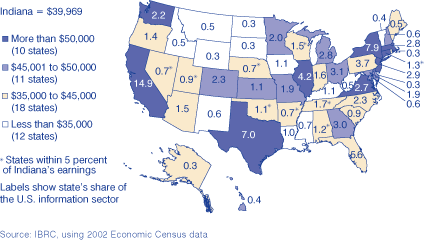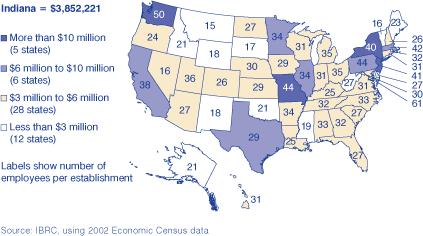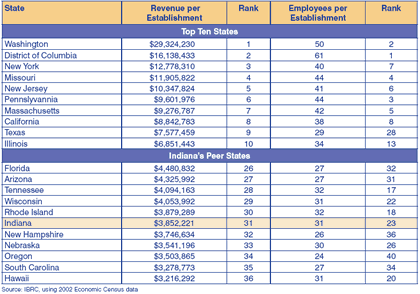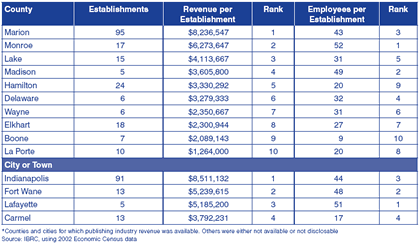Indiana's Information Sector Primarily in Telecom and Publishing
Information sector data from the 2002 economic census has been released for the nation and the state. The information sector is comprised of seven subsectors, all primarily engaged in producing, processing and distributing information. Indiana had 2,267 establishments, with the bulk of its employment in telecommunications and publishing. The Hoosier information sector made up only 1.6 percent of the nation’s establishments in this sector.
Figure 1 shows the make-up of the information sector in Indiana and the nation. Indiana’s distribution of establishments is more concentrated than the nation’s, with the telecommunication subsector outstripping the nation by 7 percentage points. Indiana’s growth rate over the past five years in this sector has been almost half that of the nation’s.
Figure 1: Information Sector Establishments
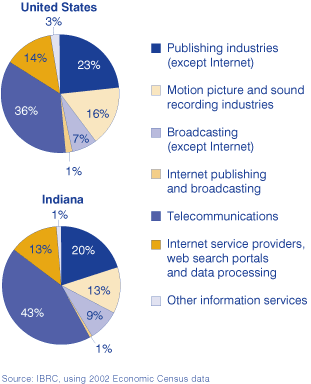
Figure 2 compares Indiana’s information sector to the rest of the nation. At $39,969, Indiana ranked 32nd in average earnings per employee. (1) Nine states came within 5 percent of Indiana’s earnings: Oklahoma, Nevada, Arkansas and Wisconsin were above Indiana, while Utah, Rhode Island, Nebraska, Tennessee and Alabama fell just short of it.
Figure 2: Information Sector Average Earnings per Job, 2002
Publishing Industry Highlights
Figure 3 looks at Indiana’s second largest subsector: the publishing industry (except internet). Note that revenue data were not available for Indiana’s largest subsector—telecommunications. In the publishing industry, the state generated approximately $3.85 million per establishment, ranking 31st among the states and the District of Columbia. Indiana had approximately 31 employees per establishment engaged in publishing activities. Indiana’s immediate Midwestern neighbors were yielding greater revenues than the state in the publishing industry but were utilizing more people to do so. The exception was Kentucky, which was generating substantial revenues but utilizing fewer employees than other states. Newspaper publishers in Indiana can claim the greatest number of businesses and employment in the industry and had 45 percent of the total revenue (see Table 1).
Figure 3: Publishing Sector Revenues
Table 1: Indiana's Publishing Sector, 2002

Click
for larger image
One might think more employees mean greater revenues, which seems to be the
case (especially with the state of Washington, which had an average of 50
employees and generated $29,324,230 per establishment). Texas’s publishing
firms are getting a lot of mileage out of their employees. It ranked in the
top 10 for revenue generation per establishment, but like Kentucky, did not
utilize many employees (see Table 2).
Table 2: Selected States by Revenue per Establishment in the Publishing Industry, 2002
Quite a bit of the county and place economic census data for Indiana is either not available or nondisclosable for confidentiality reasons, but Table 3 looks at the counties and places for which we have data for the publishing industry. Marion County had by far the greatest number of publishing outfits in the state and generated the most revenue per establishment, even though it had fewer employees per location than Monroe and Madison counties. Hamilton County, which only had about 20 employees per establishment, ranks fifth in revenue. Almost half of Hamilton County’s publishing businesses are in Carmel, and they contributed 62 percent of the revenue.
Table 3: Publishing Industry Highlights,* 2002
Notes
- Average earnings per employee is annual payroll divided by the number of employees. Payroll includes all forms of compensation, such as salaries, wages, commissions, dismissal pay, bonuses, vacation allowances, sick-leave pay and employee contributions to qualified pension plans. Also included are tips and gratuities received by employees from patrons and reported to employers.
By Amber Kostelac, Data Manager
Indiana Business Research Center, Kelley School of Business, Indiana University

